Kostenloser Versand ab 35€ Bestellwert!
-
Shop
- Insights
-
Über ROMBO
- Händler
- Plektren-Finder
- Geschenkgutschein
+Kategorien
- accessories
- bass
- bass pick
- bass picks
- bass plectrum
- bass plectrums
- beginner
- bright tone
- chose guitar pick
- chose guitar picks
- chose plectrum
- chose plectrums
- CrystalBright
- Diamond
- Diamond pick
- discipline and guitar
- DIY generation
- durability pick
- durable pick
- eco
- ecoblack
- find guitar pick
- find plectrum
- fingers vs picks
- grip
- grip guitar pick
- guitar accessories
- guitar advantages
- guitar benefits
- guitar career
- guitar health
- guitar injury
- guitar learn
- guitar lesions
- guitar lesson
- guitar method
- guitar noise
- Guitar noise plectrum
- guitar pain
- guitar pick
- guitar pick beginner
- guitar pick bevel
- guitar pick buy
- Guitar pick diamond
- guitar pick durability
- guitar pick durable
- guitar pick eco
- guitar pick features
- guitar pick grip
- guitar pick material
- Guitar Pick Noise
- Guitar Pick online
- guitar pick recycled
- guitar pick recycled material
- guitar pick special features
- guitar pick textures
- guitar pick thickness
- guitar pick variable thickness
- guitar picks
- guitar tone
- guitar warm-up
- guitarpick
- guitarpicks
- hold a guitar pick
- hold guitar pick
- hold guitar picks
- hold pick
- hold plectrum
- hold plectrums
- how to
- how to chose your guitar picks
- jazziii
- learn guitar
- lose guitar pick
- material
- materials
- mental health and guitar
- motivation and guitar
- music
- not to lose guitar pick
- Online guitar
- online guitar pick
- online guitar pick buy
- pick
- pick durability
- pick material
- pick noise
- Picks
- picks vs. fingers
- play bass fingers
- play bass picks
- play bass with fingers
- play bass with pick
- play bass with picks
- play bass with plectrum
- play guitar faster
- plectrum
- plectrum attributes
- plectrum beginner
- plectrum bevel
- plectrum characteristics
- plectrum features
- plectrum grip
- plectrum material
- plectrum noise
- plectrum recycled
- plectrum shape
- plectrum variable thickness
- plectrums
- Plek
- pua
- recycled
- recycled guita pick material
- recycled guitar picks
- recycled picks
- recycled plectrum
- Rombo Diamond
- rombopicks
- tendonitis guitar
- the guitar pick
- tone
- variable thickness
- warm tone
- warm-up guitar

WIE ÜBER 2000 GITARRENSPIELER UNS GEHOLFEN HABEN, UNSERE GITARRENPLEKTREN FÜR 2023 ZU GESTALTEN:
Im Juni 2022 haben wir die ersten 3D-Skizzen unserer vier neuen Plektrum-Modelle fertiggestellt. Die Picks waren jedoch nicht zu 100 % fertig.
Die Dicke, Größe und sogar die Namen der Plektren waren noch nicht definiert.
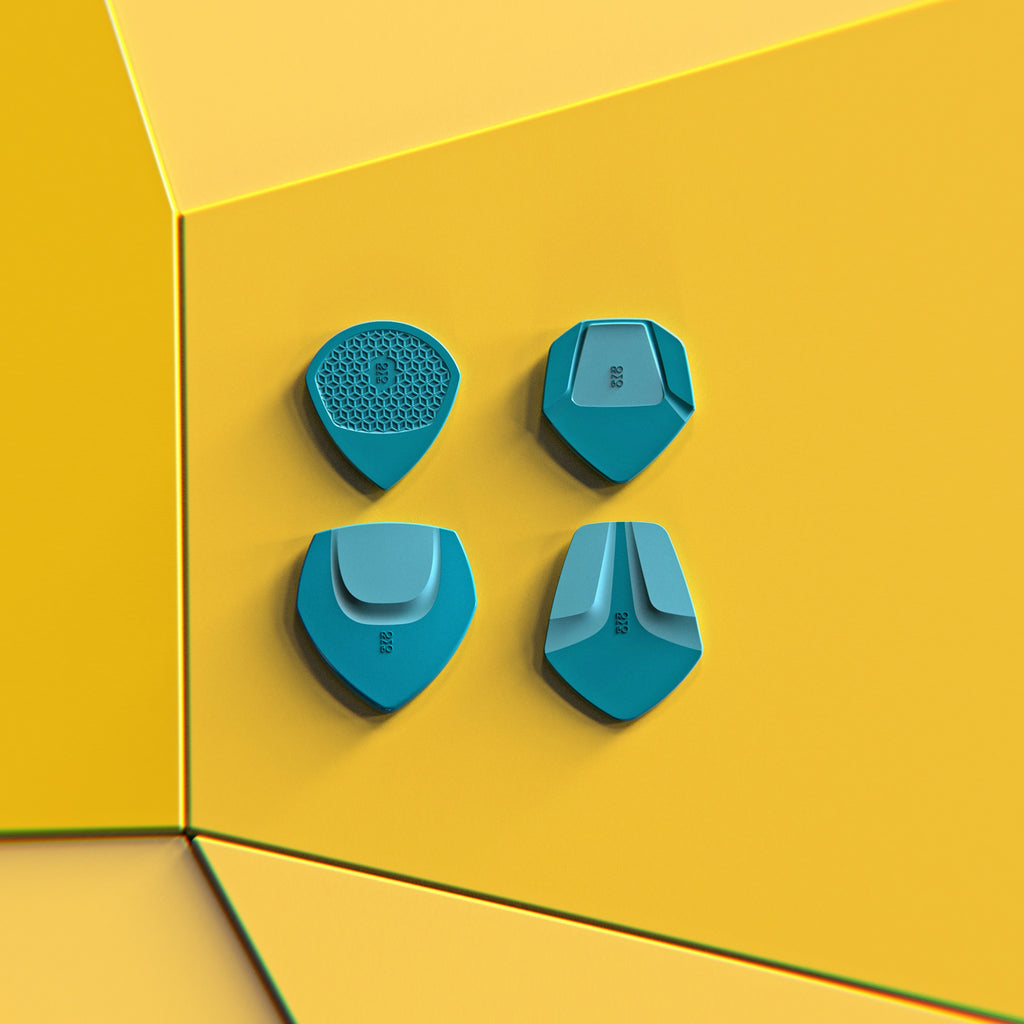
Wir haben uns für den Ansatz entschieden, so viele Gitarristen wie möglich einzubeziehen, um uns beim Co-Design unserer neuen Gitarren-Plektren zu helfen.
Das Ziel dieses Artikels ist es, die Ergebnisse der Umfrage zusammenzufassen, an der 2122 Gitarristen teilgenommen haben. Diese Leute haben das endgültige Design unserer Picks direkt beeinflusst.

Die Gitarren-Community hat Rombo seit seinem Start im Jahr 2019 stark unterstützt.
Wir wollten keine neuen Gitarrenpicks kreieren, ohne die Leute zu fragen, die von Anfang an dabei waren. Sie alle sind der Kern von Rombo, und Sie sollten entscheiden, welche Produkte wir entwickeln.
Der logischste Schritt war, eine große Umfrage zu erstellen, die es der Community ermöglicht, uns mitzuteilen, wie sie ihre Gitarrenplektren gern hätten. Wir glauben, dass dies der einzige Weg ist, ein Produkt zu entwickeln, das auf den Wünschen unserer Community basiert und uns ermöglicht, grundlegende Entscheidungen über die Ausrichtung unseres Unternehmens zu treffen.

Dies ist nur möglich, wenn man auf die Gedanken jedes Gitarristen hört.
GUITAR PICKS 2023 - ERGEBNISSE DER UMFRAGE
2122 Gitarristen haben an der Umfrage teilgenommen und sich somit am Designprozess dieser neuen Gitarren-Plektren für 2023 beteiligt.
509 von ihnen hinterließen eine private Nachricht mit detaillierten Informationen.
Weiter unten gehen wir auf diese Nachrichten ein.

WAS IST IHR LIEBLINGS-GITARREN-PICK-DESIGN?


Es gibt einen klaren Gewinner. Gitarrenplektrum Nummer 2 ist der Favorit für die meisten Teilnehmer.
Könnte es an seiner Ähnlichkeit in Form und Größe mit dem legendären Jazz-III-Gitarrenpick liegen?
Überraschenderweise ist Nummer 4 das Gitarrenplektrum, das mich während des Prototypentests am meisten überrascht hat. Aber natürlich weiß man nie, bis man es probiert hat!
GITARRENPICK NUMMER 1:

Name:
- Mosaic: 33,4%
- Pegasus: 16,6%
- Sense: 13%
- Summit 6,8%
- Andere Namen: 30,2%
Durchschnittliche Dicke: 0,66 mm
Größe: Kleine Größe mit 89 % der Stimmen
GITARRENPICK NUMMER 2:

Name:
- Shell: 42 %
- Lance: 18%
- Turtle: 8,2%
- Andere Namen: 31,8%
Durchschnittliche Dicke: 0,953 mm
Größe: Mittlere Größe mit 77 % der Stimmen
GITARRENPICK NUMMER 3:

Name:
- Erebus: 52%
- Quasar: 32,1%
- Jupiter: 10,1%
- Moon: 5,15%
- Andere Namen: 0,65%
Durchschnittliche Dicke: >2 mm
Größe: Große Größe mit 55 % der Stimmen
GITARRENPICK NUMMER 4:

Name:
- Dune: 39,8%
- Lance: 31,2%
- Doppler:19,6 %
- Sense: 4,7%
- Andere Namen: 4,7%
Durchschnittliche Dicke: 0,72 mm
Größe: Mittlere Größe mit 85 % der Stimmen
GUITAR PICKS: PERSÖNLICHE GEDANKEN VON 509 GITARRENSPIELERN

Insgesamt 509 Personen haben uns eine private Nachricht bezüglich Gitarrenpleks hinterlassen.
Wir haben sie alle sorgfältig gelesen und werden alle diese Informationen während der Entwicklung berücksichtigen.
Hier sind die 10 häufigsten Fragen, die wir wiederholt erhalten haben, und unsere Kommentare dazu:
● Werden die Plektren in verschiedenen Farben erhältlich sein?
Ja! Die Markteinführung umfasst alle regulären Rombo-Farben.
Weitere „Special Edition“-Farben sind in Vorbereitung.
● Werden sie die gleiche Griffstruktur haben?
Viele Leute haben uns E-Mails und Briefe bezüglich der Griffstruktur geschickt. Mit den Mikronoppen haben wir den Vorteil von mittelgriffigen Oberflächen, die viel Kontrolle hinzufügen.
Eine sehr kleine Anzahl von Menschen möchte jedoch, dass die Picks mehr Grip haben. Wir mussten hier eine Entscheidung treffen, und es war schwer. Wir werden die „Korndichte“ auf den strukturierten Bereichen leicht erhöhen, sodass mehr „Micro nodules“ pro Quadratmillimeter entstehen.
Auf diese Weise hoffen wir, den Bedürfnissen aller Gruppen gerecht zu werden.
● Das Material ist kühl, erzeugt aber warme und sanfte Töne. ich bevorzuge
helle Töne. Plant ihr ein neues Materialsortiment?
Wir haben unser Materialkomposition absichtlich geschaffen, um diese sanften Töne zu erreichen. Etwa 12 % der Benutzer gaben jedoch an, helle Töne zu bevorzugen.
Wir haben beschlossen, mit der Forschung an einem neuen Material zu beginnen, das als zusätzliches Sortiment auf den Markt gebracht wird, sobald wir die richtige Formel gefunden haben. Das voraussichtliche Datum für die Markteinführung des neuen Materials ist Anfang 2024.
● Warum erstellt ihr nicht für jedes Plektrum unterschiedliche Dicken?
der Modelle?
Wir möchten, dass jedes Plektrum einzigartig ist. Da jeder Mensch individuelle Vorlieben hat, glauben wir, dass jedes Plektrum sein eigenes Design haben sollte. In Zukunft hoffen wir, eine breitere Palette von Plektrumdesigns erstellen zu können, um jedes mögliche Bedürfnis abzudecken.
● Was ist mit Plektren für Bassisten?
Die meisten unserer Plektren sind mit Bass kompatibel, wie wir bei einigen Bassisten bestätigt haben, die sie regelmäßig verwenden, insbesondere Rombo Diamond und Rombo Origami. Das haben wir HIER erklärt.
● Ihr solltet Merch, T-Shirts und andere Dinge anbieten:
Vielleicht in der Zukunft. Jetzt wollen wir uns zu 100% auf die Entwicklung der Gitarrenpicks konzentrieren. Jede Minute, die wir für das Design eines T-Shirts aufwenden, wird von der Qualität der Picks abgezogen! ;)
● Werdet ihr die EcoBlack-Reihe in anderen Farben anbieten?
Das EcoBlack-Material kann derzeit nur einfarbig produziert werden.
Durch den Recyclingprozess entsteht eine sehr dunkle Pigmentierung. Die Industrie arbeitet hart daran, einen Weg zu finden, neue Recyclingverfahren zu schaffen. Wir hoffen, dass wir in Zukunft alle unsere Plektren aus recyceltem Material herstellen werden.
● Warum erstellet ihr keine Boutique-Picks?
Gegenfrage: Was ist ein Boutique-Plektrum?
Ein Boutique-Plektrum ist ein einzigartiges Kunstwerk in Form eines Plektrums, das ihr zum Gitarrenspielen verwenden könnt. Normalerweise sind diese Plektren handgefertigt und aus exotischen Materialien. Sie enthalten einige künstlerische Elemente wie Ornamentgeometrien und sind in der Regel einzigartige Sondereditionsstücke mit erhöhten Startpreisen.
Unser Ansatz ist ein anderer. Wir kreieren Boutique-ähnliche Gitarren-Pick-Designs zu sehr erschwinglichen Preisen. Andernfalls wären nur ein paar Rombo-Designs für die einflussreichsten Pick-Sammler verfügbar.
Wir glauben, dass wir auf diese Weise eine Nische zwischen Massenproduktions-Picks und einzelnen Sondereditionen gefunden haben. Mit diesem Ansatz bringen wir das Boutique-Feeling zu einer größeren Anzahl von Menschen und stärken die Plektrum-Community und das Bewusstsein für dieses kleine, aber wichtige Accessoire.
● Einige Plektren, die ich 2019 bestellt habe, hatten Grate. Dies ist kein Problem für
spielen, aber es sieht nicht cool aus.
Wir haben gute Nachrichten für Sie. 2021 haben wir eine neue Methode entwickelt, um die Grate manuell von den Plektren zu entfernen. Das bedeutet, dass alle Rombo-Picks manuell überarbeitet und bearbeitet werden, um alle visuellen Aspekte zu entfernen, die nicht zum ursprünglichen Design gehören (wie kleine Grate an der Umrandung).
Dies hat uns zusätzliche Zeit gekostet, aber als Premium-Marke müssen wir unsere Qualitätsstandards ständig verbessern, um sicherzustellen, dass eure Plektren so gut sind, wie ihr es erwartet!
● Warum nochmal Kickstarter?
Siehe unten :)
WANN SIND DIE NEUEN PICKS VERFÜGBAR?
Die neuen Gitarrenpicks kommen im Frühjahr 2023 auf den Markt.
Wenn ihr eine E-Mail erhalten möchtet, sobald die Picks verfügbar sind, abonniert unseren Newsletter (siehe Fußzeile).
Dies ist der Zeitplan, den wir für dieses Projekt erstellt haben:

WARUM KICKSTARTER?
Kickstarter-Kampagnen lassen Träume und Ideen Wirklichkeit werden. Rombo ist immer noch ein kleines Start-up, das von zwei Personen geführt wird und nur begrenzten Zugang zu Ressourcen hat. Über Kickstarter binden wir die Community der Gitarristen ein und zeigen unsere Gitarrenplektren vor dem Start.
Dieser Prozess bringt uns in Kontakt mit den echten Gitarristen. Es zwingt uns, flexibel zu bleiben, Änderungen zu akzeptieren, und es fordert uns heraus, neue Designs zu entwickeln, um die Erwartungen unseres Publikums zu erfüllen.
Wir lieben offene und kritische Kritik, und dies ist der beste Ort dafür, wo alle Kommentare und Gedanken sichtbar sind. Indem wir Ihre Erfahrungen teilen, können wir auf eure Bedürfnisse und Wünsche eingehen und Gitarrenplektren entwickeln, die einen Unterschied machen.

Common Guitar-related Injuries and how to Avoid Pain when Playing the Guitar

Playing the guitar is fun and requires numerous hours of practice. Sometimes guitarists find themselves developing pain in different parts of the body such as their wrists, back, neck, forearm, and/or fingers.
Guitarists underestimate the dangers of injuries. According to the Bureau of Labor and Statistics, in recent surveys, nearly three-fourths of professional musicians reported past injuries and pain that affected their playing.
Every guitarist I know underestimates the risks and frequency of injuries caused by playing an instrument. As with many repetitive activities (like sports), you can prevent some injuries by understanding the root cause. Being aware of this is the only way you can commit to your guitar practice and have a worry-free (and pain-free) guitar-playing routine.
In this article, we will cover the following topics:
- Reasons for injuries caused by guitar playing
- Common guitar injuries and symptoms
- How to avoid injuries and pain when playing the guitar
Disclaimer: This article is not medical advice and is not a replacement for diagnosis or treatment by a qualified medical professional. Our goal is to advise you of some preventive methods to help you avoid injuries in the first place.
1- Reasons for injuries caused by playing the guitar
Playing the guitar, there are many sources of injuries that can be overlooked.
In most cases, the pain caused by playing the guitar starts from a combination of some of these reasons:
- Practice time
- Bad posture
- Too much pressure on the fretboard
- Bad finger technique
- Lack of a warm-up routine#
- Avoiding breaks and fatigue
- Weight of your guitar
- Prior non-guitar-related injury aggravated by playing the guitar
- Genetics (like genetic chronic back pain that can be promoted by playing the guitar)
In chapter 3, we will discuss how to prevent injuries and pain caused by guitar playing and will explain some “best practices” related to these reasons.
2- Common Guitar Injuries and Symptoms
Guitar injuries are serious because they can take guitar players out of the game permanently. There are many examples of these tragedies along with the history of music and their reason is always the same—underestimating the signals that your body sends to you.

If you are experiencing pain in some of the following areas, your body is trying to tell you that something is wrong. In that case, going to the doctor is the best option. If you want to learn how to prevent these injuries, go to chapter 3.
Most injuries can be categorized as RSI or Repetitive Strain Injury. RSIs are often long-term injuries that won't go away easily. These are directly associated with specific activities that involve repetitive movements. Guitar learning is all about repetition.
If you are experiencing pain in any of the following areas, our recommendation is to take a break for a few days and visit the doctor to ensure things aren’t more serious than they seem on the surface.
2.1- Pain in the forearm when playing the guitar:
Unlike what many guitarists think, forearm injuries are not only common for the fretting hand but also for the strumming one. If your hand position is tight, your forearm muscles are likely to tighten up too.

Putting too much pressure on the fretboard or holding the guitar pick with too much tension can develop into tendonitis.
Tendonitis is the inflammation of the tendons—the tissue that connects muscles and bones together and is involved in the function of moving your body properly.
Symptoms are pain, swelling, and motoric problems like limited hand movements. Many guitarists describe it as “the forearm feels like an old rubber band".
2.2- Pain in the hand area when playing the guitar. Wrists and fingers:
We are not talking about fingertips pulp pain known by every beginner guitar player without calluses. Those develop over time, making guitar playing comfortable at some point.
The main issue in these areas is Carpal Tunnel Syndrome that not only affects guitar players, but also any kind of activity that involves fast, precise, and repetitive finger and hand movements like pianists, hairstylists, video gamers, etc.
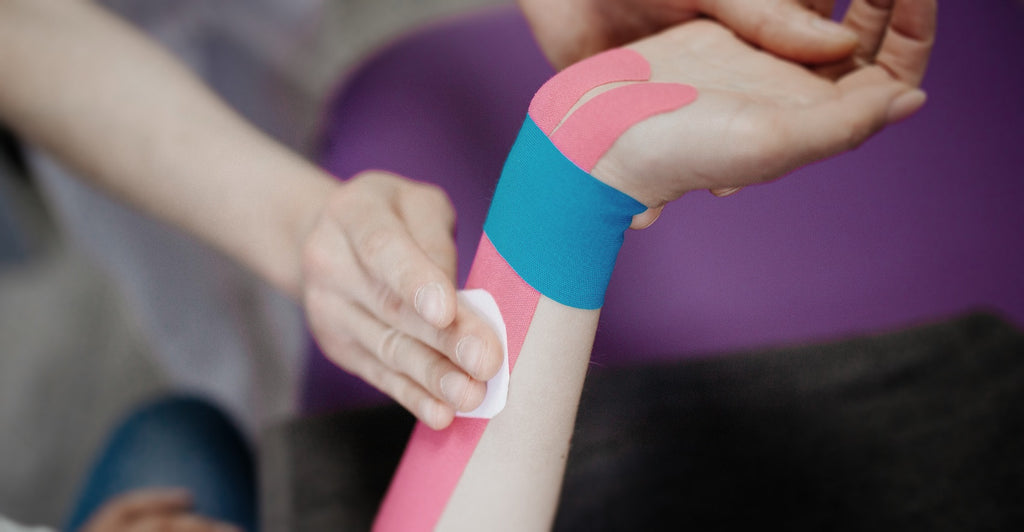
Again, the tendons are involved as in many movement injuries. The flexor tendons that go from the fingertips to the forearm can be easily stressed.
Symptoms are pain, weakness, or motoric problems like limited hand movements.
2.3- Pain in the elbow when playing guitar:
The famous "tennis elbow" is also a guitarist's nightmare. Technically, this is also an issue that concerns the tendons, and its correct name is "lateral epicondylitis."
The main symptoms are pain when gripping the fretboard or pain on the outside edge of the elbow.
As in most problems related to the tendons, the first symptoms are very subtle, and this can be ignored by ambitious guitar players who want to add some extra practice to their daily routines. If you are starting to feel this, the best way to prevent it is to have a rest for a couple of days and visit the doctor if the pain persists.
2.4- Pain in the back and shoulders when playing the guitar:
A lot has been said about posture, and this has a simple reason. Good posture habits can save you from experiencing lots of pain.
The problem with playing the guitar is that you need to position yourself in a bad posture to actually see what your fretting hand is doing properly. When you focus on the movements of your hands, it is very easy to forget what the rest of your body is doing, and you might slouch or sit with your back curved with no tension on it.
Back pain is dangerous because everything here is connected. So symptoms can appear on the shoulders, lower back, upper back, neck, and in other areas. This depends on many individual factors.
Fact is, this can be prevented by practicing good posture and holding the guitar closer to you as we will discuss in chapter 3.
This problem is very common among ambitious beginners that want to scale their skills fast.
A combination of three things causes the pain:
- Looking to your left for hours (or right if you are left-handed). As a beginner, you cannot practice without looking at your fretting hand.
- Fatigue of the neck muscles is caused by a lack of endurance. You are a beginner, so you did not have enough time to adapt to this new environment and movement ranges.
- Last but not least, lack of experience to estimate the reactions your skeleton and muscles might have.

3- How to avoid Injuries and Pain when playing the Guitar:
On an Instagram survey we performed with 455 participants, 64% reported having had some injuries in the past. This means almost two-thirds of the guitarists that participated have experienced some pain or lesions. You are lucky if you are amongst the 36% injury-free guitar players.

Simple actions can make a huge difference in your playing and help you avoid injuries and pain when playing the guitar:
3.1- Warm up before playing the guitar:
Playing at even semi-intense levels is stressful on the arms, hands, and the back and shoulders, just like a gym workout would be. So you need to treat it as a sport.
Warm-up can be something as easy as stretching your fingers or starting off your session by playing some techniques that aren’t as demanding as your current guitar level.

The cool thing about warming up is that once you start playing, your muscles are already prepared to deliver their best performance.
We have summarized our seven favorite warm-ups HERE.
3.2- Proper guitar technique, posture, and guitar position:
I am a big fan of self-learning. I have used self-learning techniques for foreign languages, technical skills, software, and cooking. However, in guitar, and especially in terms of avoiding injuries, I cannot repeat it enough: get a teacher.
A professional experienced teacher can help you not only develop your skills and define your learning path but also avoid and correct bad posture, too much finger tension, wrong guitar position, and other bad habits such as slouching when playing the guitar.

My recommendation if you do not have a teacher:
- Go for 2-3 private lessons that only focus on posture, technique, and guitar position
- Practice as per the advice of the teacher in front of a mirror
Sure, it will cost you some extra money, but it will prevent future problems that have a higher impact on your life than a couple of bucks.
3.3- Play guitar with less tension:
Typical tension areas are the forearms, fingers, and back.
What I did to avoid this is playing simple chords and phrases that I knew well and, while playing, concentrating on other areas of my body: is my back straight? Am I placing too much tension on the fretboard? Am I holding my guitar pick correctly? Can I avoid turning my neck and looking left?
Some hand tension can be avoided by holding the guitar pick properly. If are experiencing this, you can check our article How to hold a guitar pick.
3.4- Breaks and time management when playing the guitar:
There is a rule of thumb amongst experienced guitar players; 50 minutes practice, 10 minutes rest.
In the 10 minutes, you can check harmony and music theory, study some tabs or just stand up and move around to reduce your overall body tension.
This has two advantages:
- It prevents injuries by giving your body a break, and
- You will feel fresh after the break which results in higher quality practice results.
3.5- Do not play the guitar through pain:
If you experience some sort of pain while playing the guitar, this isn’t normal. Stop playing immediately and take a break, then evaluate whether you should go to the doctor or the physiotherapist.
3.6- Play sport:
Having good musculature in other areas of the body helps a lot when playing guitar:
- Muscles with more endurance resist more stress.
- Muscles that are used to exercise recover faster and fatigue slower.
- Regular sport lowers stress levels and diminishes accumulated tensions.
The combination of these aspects make playing sports a great alliance when it comes to guitar playing.
3.7- Use a lighter guitar for practice if you play standing up:
This is only logical: the less weight you put on your shoulders, the less stress you will have to handle. Some professional guitarists use light guitars for practice or even guitar stands and only use their performance guitars for their performances.
This is especially useful for guitar teachers that usually spend their whole days with a guitar in their hands.
3.8- Massages and ice for guitar pain relief:
If you treat guitar playing like a sport—and with sport, I mean high-stress levels caused by muscular movements in some areas of the human body—then you need a cool down.

Massaging your forearms and hands or using ice and cold water to reduce possible swelling can be a very simple additional routine to include in your daily practice. Furthermore, it is proven that such techniques reduce the recovery time, resulting in better practice results the next day.
This can also give your skin a break. If you are dealing with sweat problems when playing guitar I recommend you the article: 10 ways to avoid sweaty hands when playing guitar.
4- Conclusion:
Nearly three-fourths of professional musicians reported past injuries and pain that affected their playing.
Some of this pain disappears after a few days of rest. However, some injuries caused by guitar playing can be very harmful and in the worst case, they will kill your guitar career.
There are simple actions that can prevent you from injuries, such as warm-ups, good posture, breaks and other common-sense actions. The good thing is that these actions are simple and do not take much time. Even better, these actions increase your learning speed.
My advice: Reflect on your routine and consider every chapter of this article as a checklist for avoiding a guitar tragedy. Good luck!
PS: If you are a beginner and need help choosing the right guitar pick, please check our section Guitar Pick Finder or our Guitar Pick Variety Pack.

Medium Gauge Guitar Picks
Medium guitar picks are the most popular choice amongst guitarists and they offer the best of both worlds, right? Well, it is not that easy.

In our last article, “thin vs thick guitar picks”, we discussed both guitar pick thickness ranges in depth. Medium guitar picks deserve a separate analysis.
1- Why does guitar pick thickness matter?
Guitar pick thickness is usually measured in millimeters and this is an attribute that can change various aspects of a pick like flexibility, tone, volume, pick noise, durability, control over single notes, and more.

The thickness of a guitar pick is for this reason considered one of the 4 fundamental attributes of a guitar pick, along with guitar pick material, shape, and size.
2- Medium guitar pick thickness:
Medium guitar picks range in thicknesses from 0.55 and 1 mm.
The following is what a survey performed in March 2021 has shown. Thousands of guitarists were asked to define the following pick thicknesses:
- The maximum thickness of a thin guitar pick
- The minimum thickness of a thick guitar pick
With both limits established, we obtain the thickness definition of medium guitar picks.

The maximum thickness of a thin guitar pick was defined as about 0.55 mm by 2.292 guitarists.
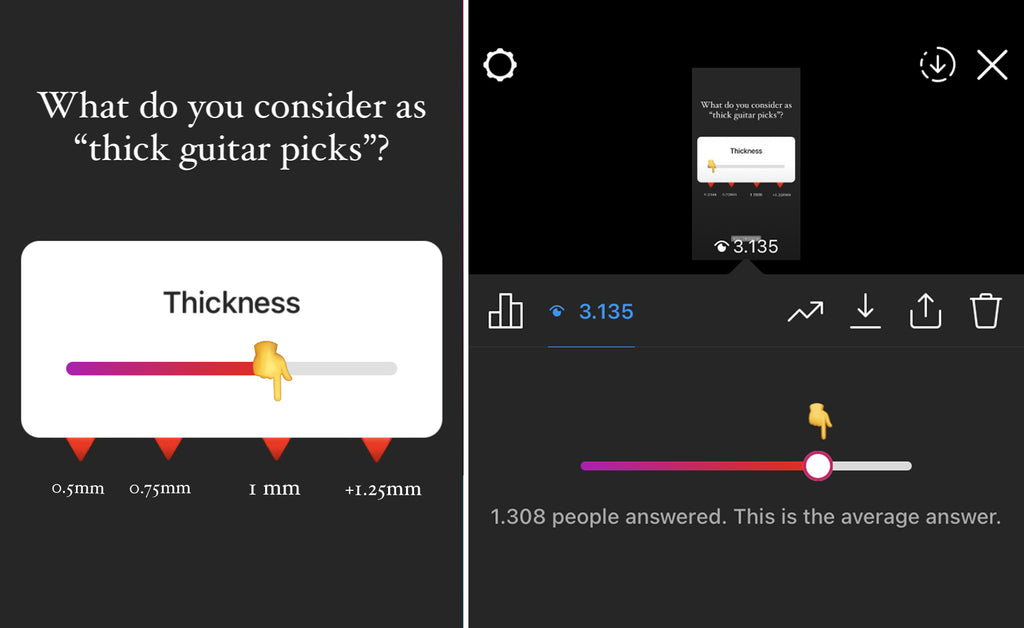
The minimum thickness of a thick guitar pick was defined as 1 mm by 1.308 guitarists.
3- What is a medium guitar pick?
Medium guitar picks are guitar picks with a thickness between 0.55 and 1 mm. These guitar picks are very popular because of their versatility; in some areas, they offer the advantages of both thin and thick guitar picks.

Medium gauge picks have the broadest flexibility range. In this pick thickness interval, the material will play the most important role when it comes to defining the flexibility of a pick.
In other words, thick guitar picks are always stiff and rigid. With thicknesses over 1 mm, even the most flexible pick materials are stiff, and therefore the material has less influence on the flexibility of the pick. This relation creates a broad flexibility range amongst medium guitar picks, which can be very flexible or very stiff, depending on the material used.

The same effect can be applied to tone, durability, and pick noise.
Typically, medium guitar picks are used by lead guitarists who also implement rhythm guitar techniques and look not only for an all-round compromise between single-note melodic phrases and strumming, but also potentially developing a more versatile guitar career that integrates different techniques and mixes both worlds together.
4- Thin, medium and thick guitar picks:
|
|
Thin guitar picks (under 0.55 mm) |
Medium guitar picks (0.55 - 1 mm) |
Thick guitar picks (over 1 mm) |
|
Flexibility |
Flexible/very flexible |
Medium flexibility or stiff, depending on the material. |
Rigid/very rigid |
|
Tone |
Lighter tones, less bass |
Warm tones for softer materials. Brighter tones for harder materials. |
Warm/dark tones and mellow tones |
|
Volume |
Maximum volume is limited. Lower dynamic range. |
Can provide high volume with the usage of hard materials. |
Provide high volume. Broader dynamic range. |
|
Guitar pick noise |
Noticeable pick noise |
Reduced pick noise when the pick has a variable thickness. |
Reduced pick noise |
|
Durability |
Less durable |
Depending on the material. |
More durable |
|
Control |
Less control for single notes |
Very versatile. Control of single notes is possible if the player is experienced with this type of pick. |
High control of single notes |
|
Popular techniques |
Rhythm guitar, strumming, tremolo picking, ... |
Very versatile. A combination of both thin and thick guitar picks is possible if the player is experienced with this type of pick. |
Lead guitar, shredding, sweep picking, ... |
|
Common type of players |
Beginners, acoustic guitar players |
Most popular thickness. Medium thickness is used by beginners, intermediate and advanced guitarists. |
Intermediate and advanced guitarists |
This makes medium gauge guitar picks the most difficult picks to estimate without having tested them, and it is one of the reasons why we created the “guitar pick parameters” included in every product page, like in Rombo Origami.

5- Medium guitar picks are the best picks for beginners:
For most beginner guitar players, medium gauge guitar picks are the best option. You are in a process in which experimenting with sounds and learning new techniques will shape your profile as a guitarist in the future.
You might change your music taste during this process or even change your guitar type. You must stay flexible and versatile to allow your skills to develop in all directions and be a more rounded guitarist.
For this, a medium guitar pick is perfect, since you will be able to try different techniques with a pick that works very well in many different areas. After you have decided the direction of your development as a guitarist, increasing or decreasing the gauge won’t be that difficult.
Therefore, this is statistically the best option to start with if you want to try different guitar learning paths.

However, there are some exceptions: Some beginner guitarists know exactly what kind of player they want to be. They know from the very beginning if their dream is to become a very technical metal player, if they prefer being an expert acoustic guitar rhythm player, or if they will focus on songwriting and not on their guitar skills.
These examples are very rare, but they exist. In this case, you might want to consider starting with a guitar pick that has been designed for the type of skills you want to improve.
If you are a beginner, this might be interesting for you: Guitar pick for beginners
6- Medium guitar picks at Rombo
Rombo Origami guitar pick - 0.75 mm
Flexible but still rigid enough for note control. Right amount of flexibility for a snappy fluid attack that's bright and crisp. The concave surface on the hold area ensures ergonomic and comfortable hold.

Rombo Prisma guitar pick - 0.8 mm (available in September 2021)
A classic shape enhanced by modern surface technology. The geometry on the main body has different height levels for the most comfortable hold and grip.

Rombo Crisp guitar pick - 1 mm (available in September 2021)
Medium thickness combined with geometric concave design surfaces. The result? Unexpected flexibility with great bass tones. Its medium-sharp tip provides extra warm tones.

7- Conclusion on medium guitar picks
Each pick has a specific purpose, and you choose the pick based on the sound you want to achieve as well as other personal preferences like comfort and grip.
Medium picks are not just the picks in the middle of thick and thin guitar picks. They are a perfect approach for those guitarists looking to develop versatility and flexibility in their learning path.
Due to the high influence the material has on these picks, they are the most difficult picks to estimate before testing them, and every medium guitar pick is unique. Despite this, they are the best choice for most beginner guitarists.
However, if you have a very clear idea of the skills you want to develop in the future, you might be looking for either thin or thick guitar picks, which we discussed here.

Do Guitar Picks Make a Difference? - Guitar Picks 2021
Reinventing the Guitar Pick: Rombo 2.0
In our first campaign, we focused on outstanding technology at affordable prices. We are now determined to take this to the next level and have designed our guitar picks as an extension to your hands, using the latest technology, materials, and smart models, with your comfort in mind.
We are now focusing on YOU, and your experience, using a fresh design.
Rethinking the Idea of a Guitar Pick
Guitar picks are the bridge between you and your instrument. A hidden hero in the hands of guitarists. A guitar pick is a very personal item and choosing the right one depends on several factors.
 Rombo Jade Guitar Pick Set in color Honey Yellow
Rombo Jade Guitar Pick Set in color Honey YellowBack in 2018, ROMBO was born with a mission: Question every aspect of a guitar pick, to redefine what the user really needs. We started our personal search for the perfect balance between tone and ergonomics.
We have learned a lot during the last 3 years, and finally, we are ready to offer new experiences to guitar and bass players around the globe.

Rombo Crisp Guitar Pick Set in color Graphite Black
Try Out Mix Guitar Pick Set
Fresh Approaches
During the creation of these new 4 plectrums, we used the following rules as a guideline:
● Work very closely with many professional guitarists.
● Question our own first designs
● Redefine what a user needs to get the best performance.
● Perform in-depth research, to find the best material improvements.
In addition, we conducted a big survey, (1552 guitarists from 31 countries participated), to define the thicknesses, shape, size, and even the names of the new guitar picks.
After a long product development process, we have reached the point where we are extremely happy with the results!

Rombo Horizon Guitar Pick in color Graphite Black
The constant Search for the perfect Material
We are using a thermoplastic polymer, which belongs to the family of the polyamides. This material is used in aerospace and automobile industries, and has high mechanical strength, excellent impact resistance (guitar strings), and superior aesthetic properties.
We believe we have achieved an excellent balance between sound, comfort, grip, aesthetic properties, and durability.
In addition, we offer all our picks in EcoBlack: A 100% recycled material from pre-consumer fibre waste.

Rombo Guitar Pick Set EcoBlack material

Special Attributes we always wanted for our Guitar Picks
When it comes to guitar picks there are four main attributes: thickness, shape, material, and size. These attributes define 80% percent of a guitar pick.
However, the last 20%, contains improvements, and attention to detail, making the playing experience much more comfortable, giving you better results, and a more enjoyable playing experience.
These aspects are essential, to get the most out of this guitar accessory.
Here are the 6 features we have defined for all of our ROMBO guitar picks:


A mirror polished guitar pick reduces friction between guitar pick and strings. With every impact, the guitar pick will suffer less friction and therefore wear down slower. The pick will glide better, and produces less pick noise.

All of our picks have variable thicknesses: The solid and thick body, gives you a better grip and control. The thinner tip will give you enough flexibility to achieve greater versatility when developing different guitar techniques.
What makes a Guitar Pick durable?
The attributes that define the durability of a guitar pick are as follows:
- Guitar Pick Material
- Guitar Pick Thickness
- Guitar Pick Tip Shape
- Guitar Pick Tip Texture
Harder materials will wear down slower. This is one of the reasons there has been a lot of research in the area of suitable materials for guitar picks.
The goal is to find a wear-resistant material, that keeps the tone characteristics that guitar players want, while still giving a good grip.
Other attributes of the pick that affect the durability, are the Tip Shape, and the Tip Texture. Very pointed guitar tips tend to wear down faster, because there is less material on the tip.
However, this problem can be partially solved with the right guitar pick tip texture. A polished tip on the guitar pick will cause less friction between strings and plectrum.
Surfaces and Textures on Guitar Picks: Finding the Balance
Textures on guitar picks, define not only the important aspects like grip, control, and friction between the strings and guitar pick, but also focus on the equally important details, like comfort, pick noise, and design.
We believe textures on guitar picks are essential for a tool that was designed to be held between your fingers.

The combination of two different surface finishes in the guitar picks, have convinced us, and our testers, of the potential gains a player can achieve:
- A polished tip for clarity, durability and control
- A micro-nodules texture in the centre of the guitar pick for the most comfortable holding without compromising grip

Rombo Jade Guitar Pick Set in color Honey Yellow

Rombo Prisma Guitar Pick Set in color Graphite Black

Rombo Horizon Guitar Pick Set in mixed colors

Rombo Crisp Guitar Pick Set in color Honey Yellow
The New Rombo Guitar Picks
ROMBO HORIZON - 1,4 mm
The wide curvature on the body and tip allows you to slide smoothly through the guitar strings. Its curious-shaped raised hill on the body ensures splendid comfortable hold.
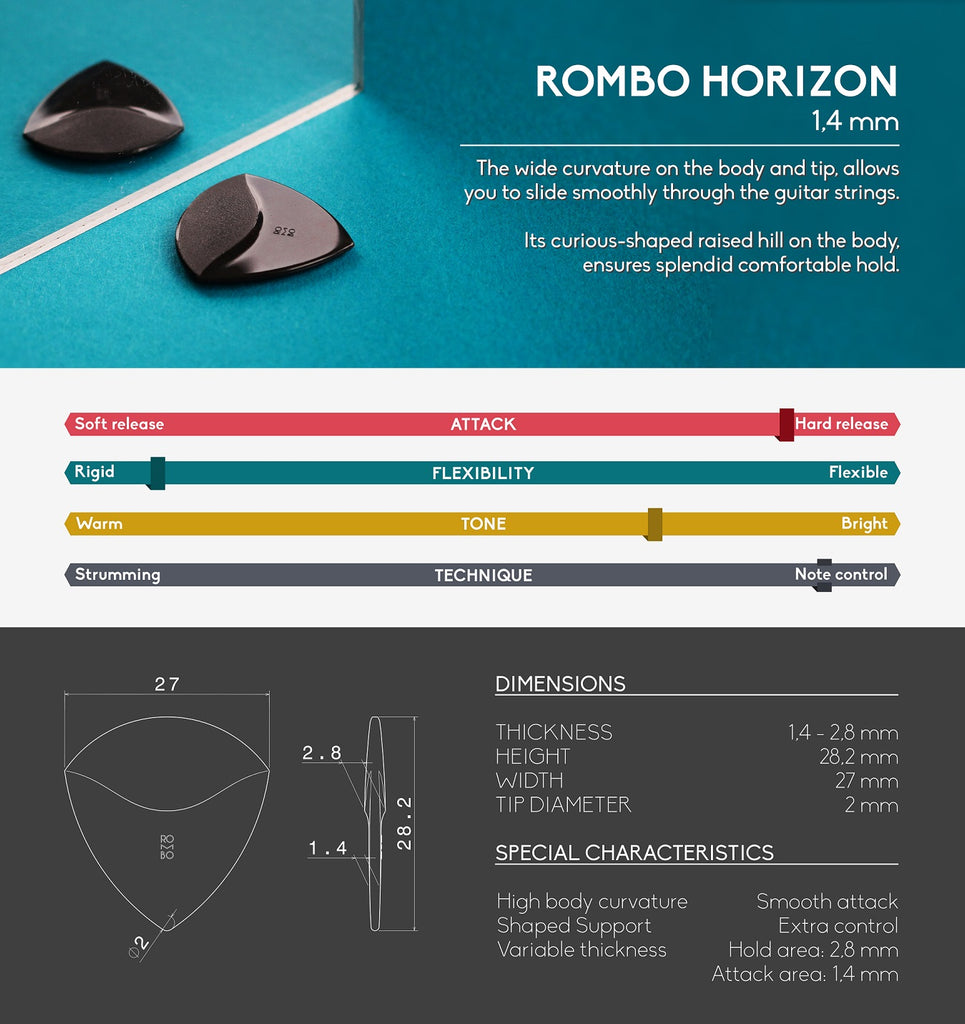
ROMBO PRISMA - 0,8 mm
A classic shape enhanced by modern surface technology. The geometry on the main body has different height levels for the most comfortable holding and grip.

ROMBO CRISP - 1 mm
Medium thickness combined with geometric concave design surfaces. The result? unexpected flexibility with great bass tones. Its medium-sharped tip provides extra warm tones.

ROMBO JADE - 2,3 mm
Maximum precision. Perfect for shredding guitar techniques. Its wide bevel edge, combined with a decent body thickness, provides a supreme attack, without compromising bass tones.


Inside Rombo Guitar Picks: Guitar Picks developed and engineered in Germany
This article was created because you asked for it. It is meant to be as transparent as possible, so that you can see who the faces behind Rombo are and how we organize this project internally.
We hope you enjoy it!
Rombo Guitar Picks: Short Introduction
Since 2019, Rombo has been researching surface finish and design in order to find the perfect balance between grip, ergonomics, and function in guitar picks and other guitar accessories. Rombo was born thanks to an amazing guitar player community whose aim is to continue this adventure and quest for the perfect guitar accessories.
Who are the faces behind Rombo Guitar Picks?
We are Judith and Carlos, a happily married couple trying to innovate in the world of guitar picks. We live near Stuttgart, Germany.

We both love music, guitars, product development, challenges, and attention to detail, so Rombo was the perfect excuse to mix all these things together and have some amazing adventures.
Our location in Remseck a.N., Germany
Packing and shipping of our guitar picks
From Remseck, near Stuttgart in Germany, we do almost everything.
Here, we receive the packaging and the dots we use to fix the guitar picks to the packaging. We try to be very organized and keep the place very tidy. Tidy places also look better for photographs!

In the shipping station, there is one tray for every guitar pick model. We also include a flyer and a “thank you”-card with every delivery. This way we make the experience more personal, while sharing our journey of packing your guitar picks directly with you!

We have a label printer, which is super useful, and thankfully our web system allows us to automate the printing for every customer and create a label with just one click.
Our post carrier receives the boxes from us with all the information they need to bring our products to you, including weight, countries, and import information for the customs.

We ship every order directly from our location.
The envelopes we use are not very cheap, but they protect the product well, they are made of 100% recycled paper and they are plastic free.

Always learning something new
We have to be very multifaceted to cover all the tasks we do, from idea generation, product development, graphic design, photography, web maintenance, logistics, social media, packaging development, and accounting, to all the stuff a start-up involves.

We believe that doing everything by ourselves gives us a very close perspective from the customer side.
This means, when you ask something on Instagram or Facebook, you receive an e-mail from us, or we answer your comment. It is us behind the screen typing every word and every smiley!

We love walking a lot. We go for a walk for 5 kilometres almost everyday. Almost every idea we applied to Rombo was created while having a walk. We called it our daily inspiration walk.

Rombo is a long journey
Two years ago, at the very beginning of this journey, we could not have imagined how many things we needed to learn!
We have encountered many challenges on the way; for example, I remember it was very difficult to find out how to sell internationally and establish a system that is fast enough for us.

I cannot tell how many books on startups, online marketing, Kickstarter or time management we have read! One of the most useful ones was A Crowdfunder's Strategy Guide: Build a Better Business by Building Community, by Jamey Stegmeier.
A funny anecdote is that Judith and I don’t have our own Instagram profiles. For the first post from Rombo, we had to check out a tutorial on Youtube to try to understand the process. I am glad to say that two years later, we have reached almost 20K followers!
PS: We still don’t have our own accounts, the one for Rombo is enough work! :)
Guitar picks: All about the design process
The most complex part is the design process of a guitar pick.
I like to sketch a lot, so I have lots of old ideas and sketches which I use as an inspiration source. Sometimes, we use questions to challenge the design process, like “Is it possible to create a guitar pick that is flexible and rigid at the same time?” While trying to answer this question, we came up with the idea of “variable thickness”, which has proven to substantially increase ergonomics.

Since we have an engineering & design background, we also do the modeling in 3D and product engineering. Every detail is important here to create high-quality products.

When we think the design is ready, we create some prototypes and send them to the testers. If you follow us on social media you will know some of the testers from our stories.
In total, we have about 30 guitar players that help us during this phase of the project and communicate with us which points they liked or didn’t like. Thanks to their feedback, we are able to improve areas of the guitar picks which we would otherwise not have thought of.
Manufacturing technologies
For the manufacturing of our guitar picks on a large scale, we use a technology called injection molding.

In this process, the melted raw material is injected into a mold with the negative shape of the guitar picks.
It is a very complex process with lots of engineering in it, the material has to be treated in a special way to keep the proper humidity, temperature and pressure, and to avoid external contaminations.

On the left, the injection mould from Rombo Diamond: Our polimer flows through the mould runner (yellow arrows) after it reaches over 270°C degrees and it is pushed forward.
The red area is the area we use for the grip texture. The blue area is high mirror polished.
On the right: The first ever produced Rombo Origami from 30.11.2018. The first 50 guitar picks we produced were sent to guitar pick testers who gave us feedback about the material, the grip, the tone and the shape.
The raw material we use is produced in Italy. We have worked very closely with our material partner to accomplish every requirement we had, including the 100% recycled material of the EcoBlack sets. If you want to know more about the materials we are using, you can find more information HERE.

Packaging for guitar picks
We believe packaging is a very important aspect of a product. We not only use it to create an atmosphere and emphasize the quality of the product, but also to inform you about the attributes of our guitar picks.

This is the reason we created packaging with lots of printable areas to describe the guitar picks. We include our parameter bars, a short description of the guitar pick, the 6 special attributes of a Rombo guitar pick, and a QR-code with extra information.
We had a total of about 6 different concepts before we decided which one was the most suitable.
Right now, we are creating the packaging layouts for the new models that will launch in 2021. We have received some samples and they look great!


If you want to see the new models, you can click HERE.
Guitar picks and social media:
Rombo product photography:
Carlos takes the pictures for social media. We are not very skilled with the camera, but we have learned a couple of tricks and after thousands of trials, we are able to take decent pictures in our living room.

In our Instagram you can find the best pictures.
Educating the customer
You have probably noticed that our posts on Instagram are mainly informative. Guitar picks are often underrated and most guitar players don’t think much about it.
However, guitar picks are the loudest amplifier you can have in your hands and are the bridge between you and your guitar.

We try to pass the know-how we have obtained directly to you, so you can make conscious decisions about the products you purchase. Aspects like the variations on the tone depending on guitar pick thickness, or why are there so many guitar pick shapes and materials… And this is the reason we created our blog articles.
Our aim is to create a communication process that goes back and forth between us. Some of you have become friends of ours and have won a new perspective of thinking about guitar picks.
Engagement of the community
“To listen closely and reply well is the highest perfection we are able to attain in the art of conversation.” – François de La Rochefoucauld, essayist.
We believe we have one of the most engaged communities ever! We try to answer every comment and every private message, and we are sure we have an answer rate very close to 100%.
You all have participated in surveys, and you have left amazing comments and reviews. You post stories regularly and we have had very deep conversations with some of you! Thank you!
We also received great support from many amazing blogs like Heavy Repping, Gigs and Guitars, The Gadget Flow, Ultimate-Guitar, Guitar World, and others.
Rombo around the world
Rombo is expanding. We are working with dealers around the world and currently we have sellers in the following countries:

This means, with the help of our dealers we are able to sell in Europe, North America, Asia, Australia, almost every country of South America, and South Africa.
Transparent communication with our dealers is a priority with us, and so far 100% of the new sellers stay with us! Together we are developing the brand and taking it to the next step.
The future of rombo:
During our inspiration walks, we talk about Rombo in the next few years. It is very difficult to imagine what the future will bring.
We would like to bring new designs (lots of them!), to increase the amount of recycled material for the manufacturing of the picks, or even be able to create colored recycled guitar picks. We want to talk more to our customers and share our experiences, and from time to time, share some great music and playlists.
We are only two people and every step takes its time. Some of you have written beautiful thank you letters to us or left very good reviews and we want to let you know that we are working hard everyday not to disappoint you :)
You are the best and you have a vote on the future of Rombo!

7 Easy Warm-Ups Every Guitar Player Should Know
As a guitarist, the best way to start every practice session is by warming up.
In addition, integrating different techniques will immediately improve your skills and will prevent injuries.

Whether you are planning a studio session, a jam with your friends, or some solo relax sessions at home, a conscious warm-up before playing guitar is mandatory. No matter if you use guitar picks or play with the fingers, there are no excuses.

This 7-step warm-up will help bring your playing to peak level. Developing the habit of warming up your hands and upper body will improve your posture and make your playing look “easy” and relaxed.
1- Don’t Play Guitar with Cold Hands
Cold hands make guitar playing very difficult.
You will notice this during your first guitar chords. Your fingers and hands won’t be agile enough to play your guitar and you will struggle holding your guitar pick.
Running your hands under warm water is the fastest way to get the temperature your fingers need to improve the blood circulation.
Combine it with the step 2 and get the best results.

2- Massage your Hands before Playing Guitar
When it comes to guitar, our hands are our most precious tools.
The hand muscles tend to tighten up. In order to loosen them, you can do a hand massage.
Some musicians may hit a plateau or wall in terms of their speed or dexterity, because by not taking care of their hands properly, the muscles of the hand and fingers are tighter and less supple. It seems a no-brainer.
If you rely on your hands for your income/career, you want to do what it takes to keep them as healthy as possible.
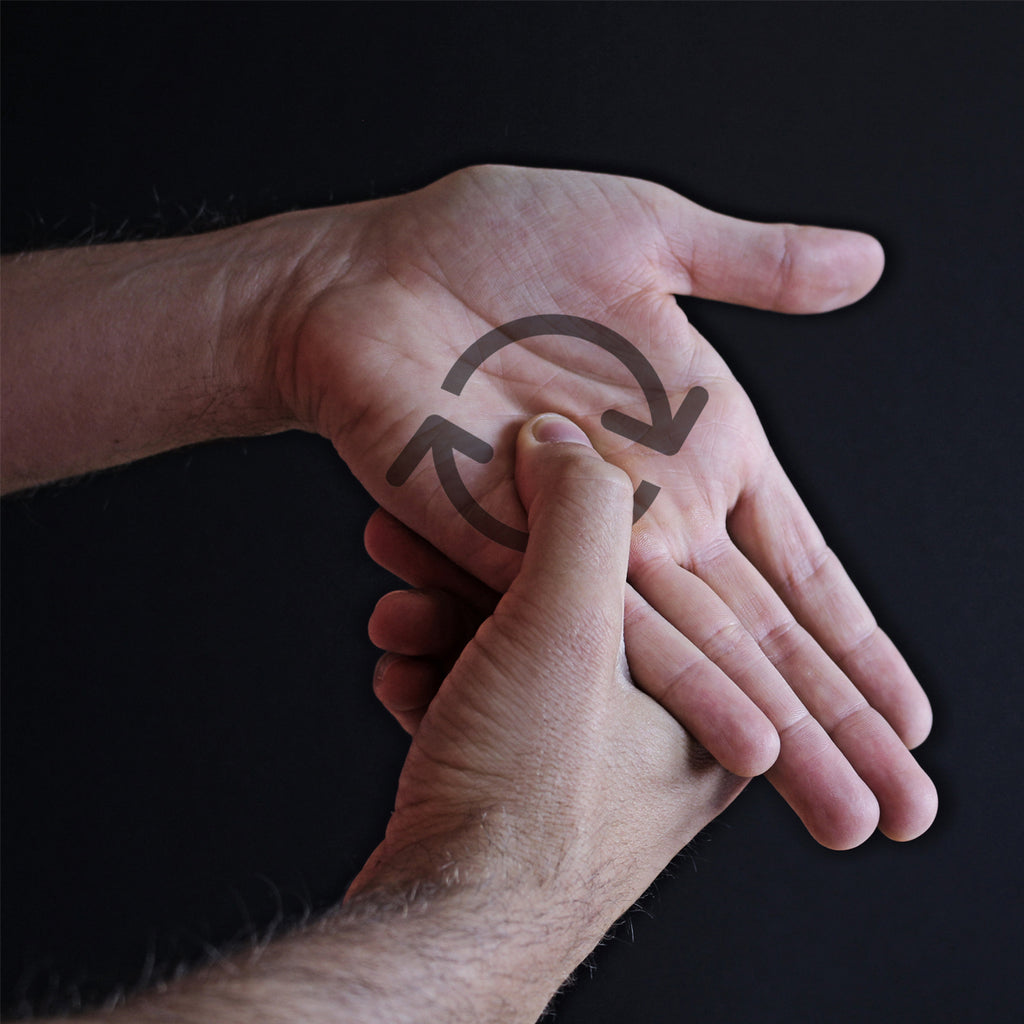
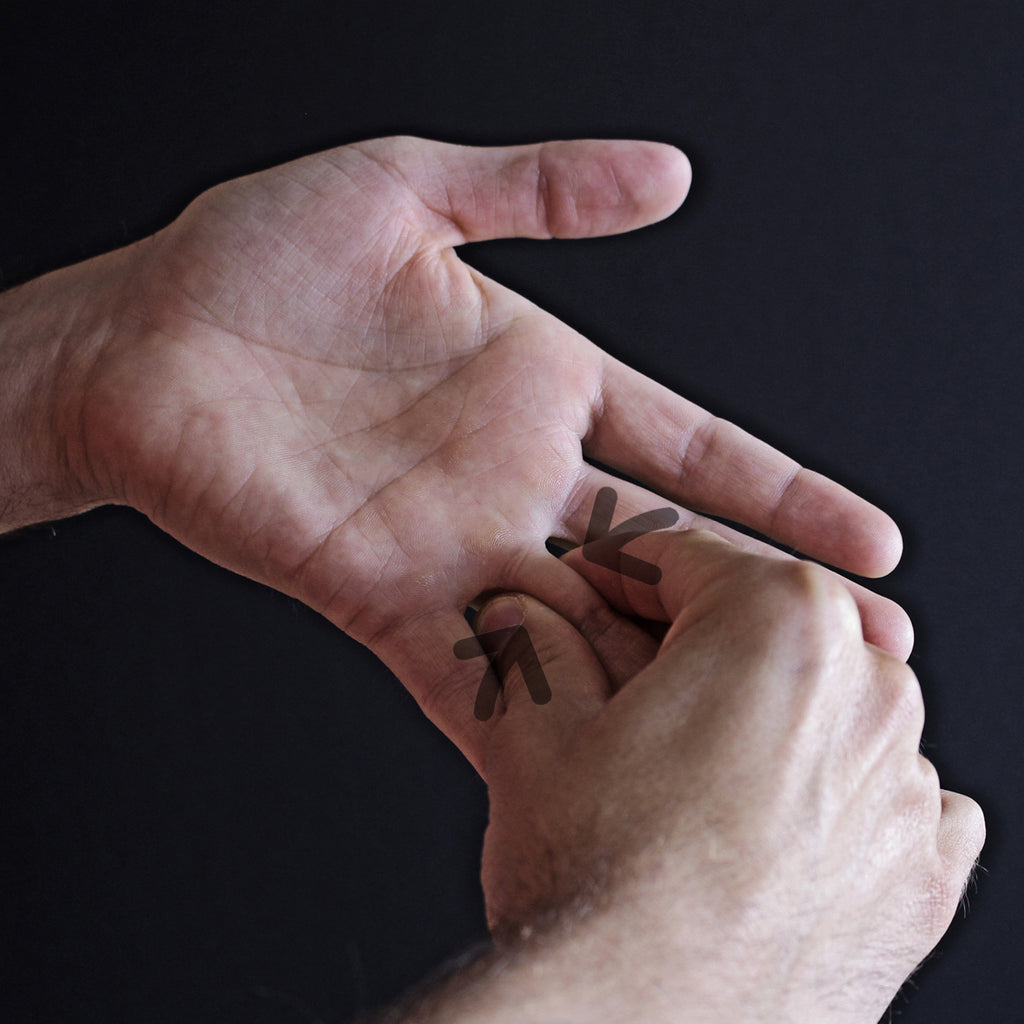
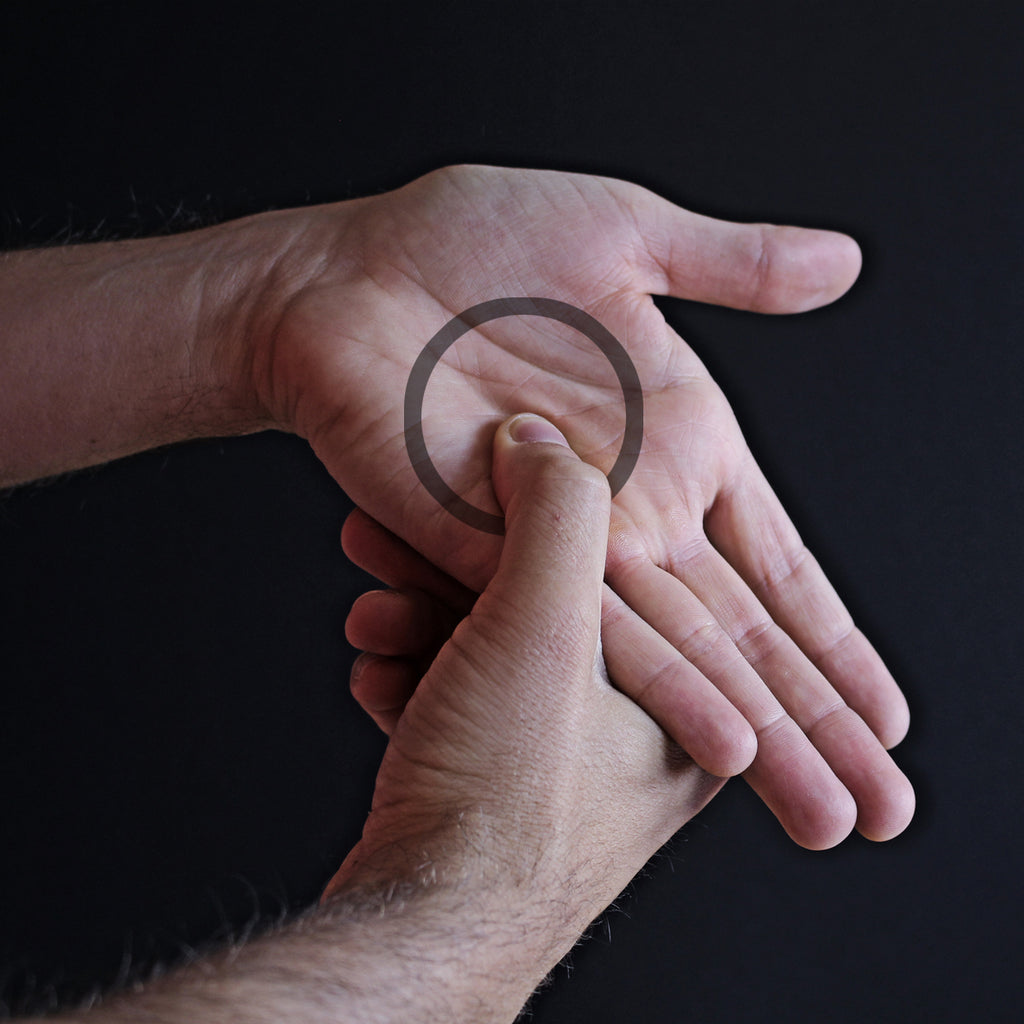
A proper holding of your guitar pick is necessary to avoid pain. Do you know how to hold your guitar pick the right way? Click HERE and learn more.
3 -Shake your Arms, Hands and Body
Every muscle is connected. Your hands, wrists, forearms, shoulders and back should all be performing their best during your practice.
To get the blood flowing through your body, simply move your arms and legs, shake your arms and back, and then make a fist, opening and closing your hands at least 10 times.
This exercise will not only prepare your hands, but will also relax your body and help to get the preparation you need before playing your guitar.
4- Use a Ball and squeeze It
A ball is an excellent way to warm up your hands before you practice guitar.
If you implement this in your routine, you will be able to do every exercise quickly, in just a few days.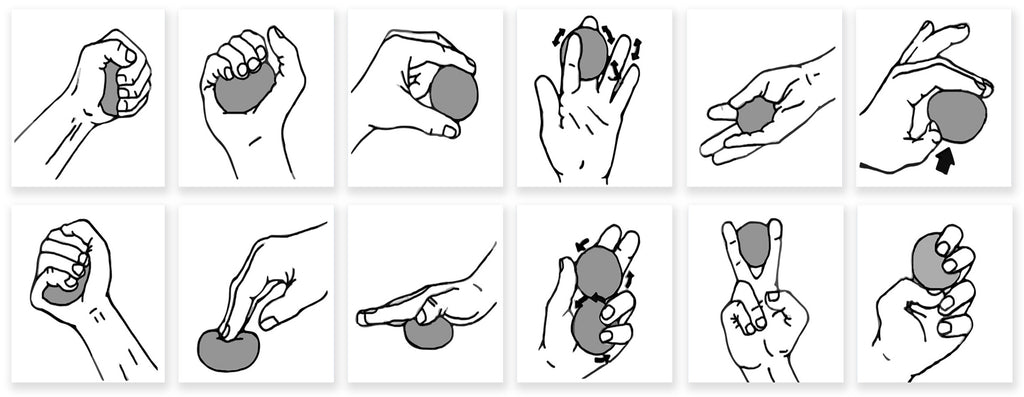
This method was mentioned in the article “Play Guitar Faster - Guitar Methods for Speed Playing”, which you can find HERE.
5 - Stretch your Fingers
The last thing to do, before moving on to playing your guitar, is to lightly stretch your fingers.
Stretching your fingers helps to enhance flexibility. It lengthens tight muscles and prevents injuries.

Playing guitar can cause fatigue to these areas, and stretching helps to keep the muscles loose and limber. It increases flexibility, and your range of motion.
Stretching your fingers before playing guitar will warm up muscle tissues and joints.
6- Play Something that is not emanding for your current Guitar Skills.
Try playing some simple exercises, melodies and/or chord progression.
Here some ideas you can use for your routine:
- Simple scales, such as the minor pentatonic scale.
- Riffs or songs you already know
- Technical exercises you already master (For both hands).
- Picking patterns – either fingerstyle or with a guitar pick

If you are using a guitar pick, you might have to practice some specific techniques depending on your music style. If you are not sure which guitar pick is the right one for you, check this guide HERE.
If your hand is still sore, repeat some of the steps. Especially in the winter months, as the hands can get cold very fast.
7- Take a Minute to concentrate and focus Yourself
Some guitar players keep playing the stuff they already know, and have given up practicing to improve.
Try to be focused on your role, and separate the habit of playing for fun or relaxing, from the habit of playing guitar for improving.

Take a minute, breathe, think about the next 90 minutes, and focus on the guitar.
Now you can avoid Guitar Playing Injuries, and improve your skills:
While playing guitar you are moving your muscles to make a specific, complex series of movements and hand positions.
With cold muscles and no time to adapt to your exercises, your hand tissues can develop micro-tears that lead to injuries or pain.
But that is not all, it is proven that the right warm-up will immediately improve skills like guitar speed, precision, concentration, and resistance.
Bonus Track: Take a Break!
Some guitarists play for hours.
If you are one of those ambitious musicians, trying to become one of the best 5% of guitar players, you need to take enough breaks and relax the muscles. 
Stand up every 60 minutes and repeat some of the mentioned exercises. The best way to do so is to set an alarm and be disciplined enough to stop your training, when the alarm goes off.
Leave a comment and tell us if this is useful!
Thanks!
Folge uns
Judith Heindorf & Carlos Diez Macia GbR
Auf der Steige 29
71686 Remseck am Neckar
DEUTSCHLAND
- Shop
- Händler
- Impressum
- AGB
- Widerrufsrecht
- Versandbedingungen
- Datenschutzerklärung
- Kontakt
- Presse
- Fragen & Antworten
Melde dich zu unserem Newsletter an und erhalte alle Neuigkeiten zu Sales, Neuerscheinungen und vielem mehr…
Mit der Anmeldung stimmst du unseren Datenschutzbedingungen zu.
© 2025 ROMBO.
ist eine registrierte EU-Marke.
Wir nutzen Shopify.



